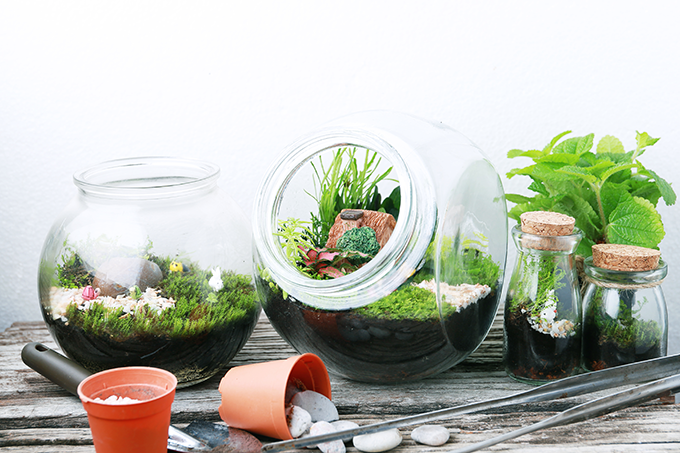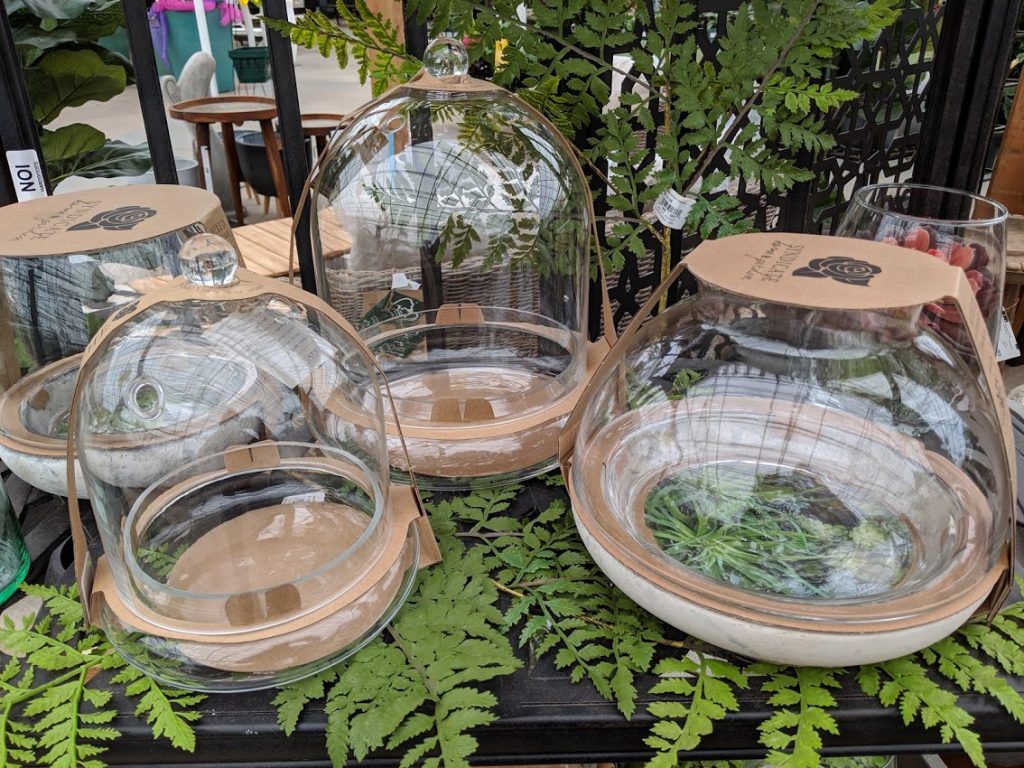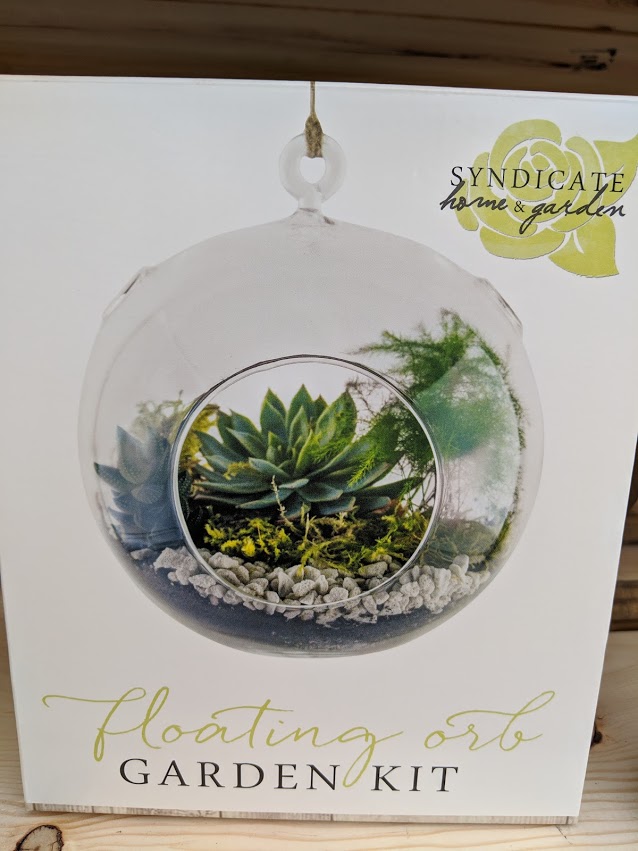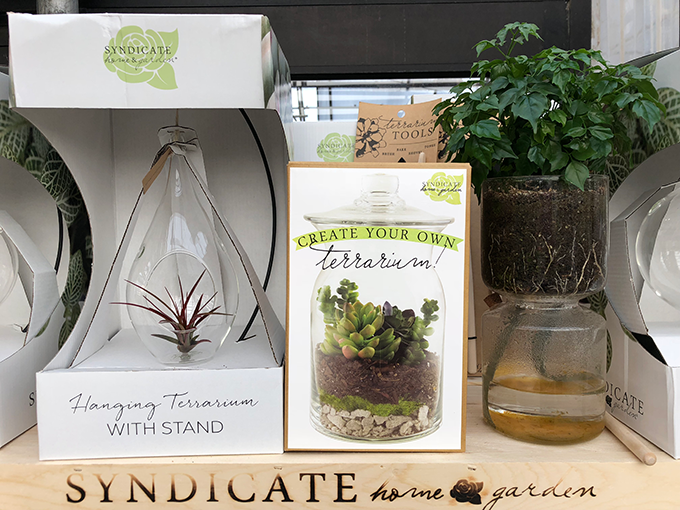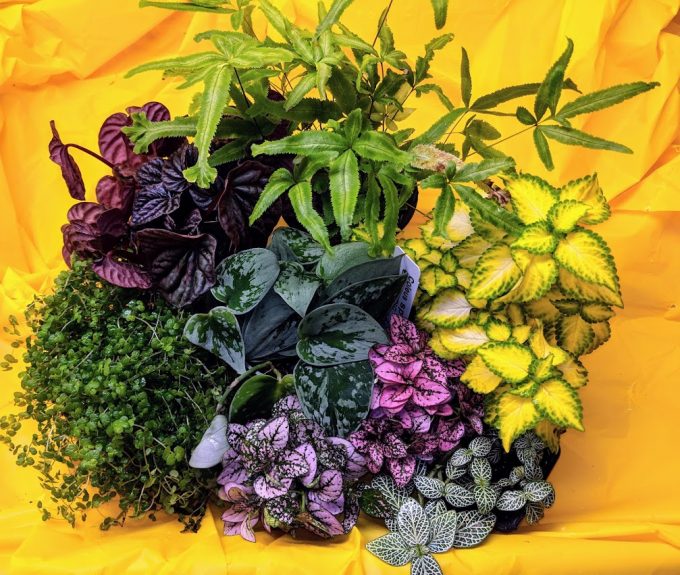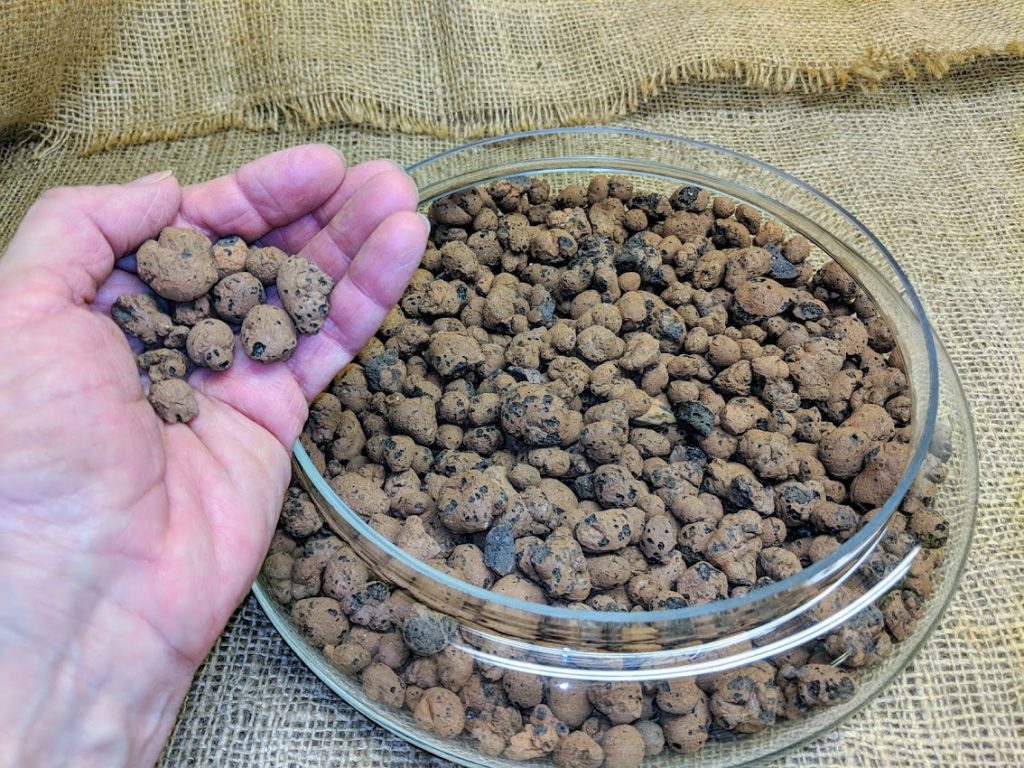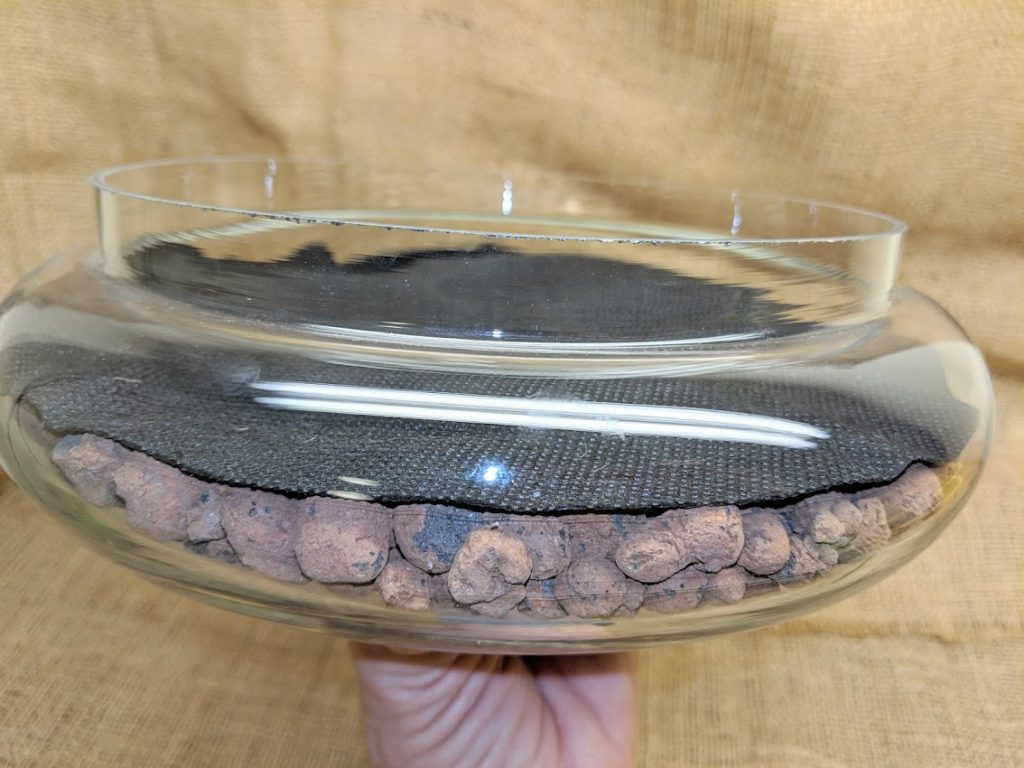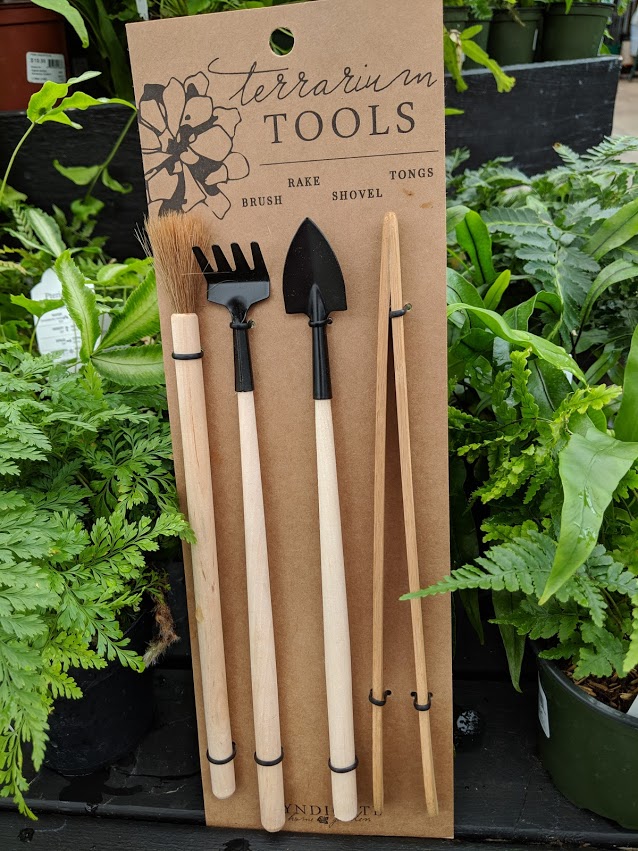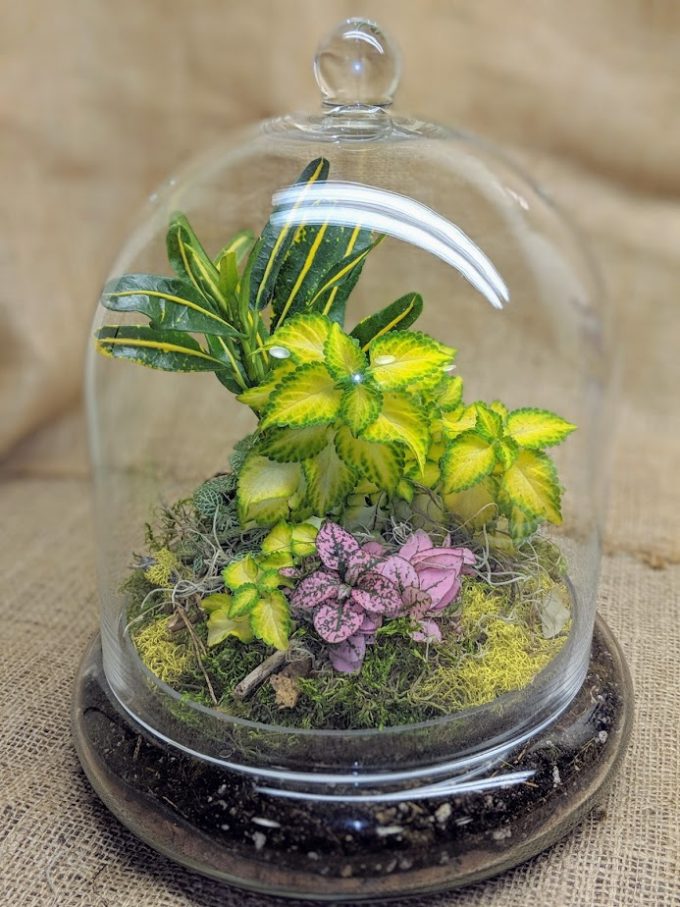As we wait for the return of warm weather and our outdoor gardening season, now’s the purr-fect time to design and plant your own indoor garden: a terrarium. It’s a great way to unleash your creative juices and get your hands dirty! Let’s walk through a few basic terrarium “how to’s.”
Think light and location first
It’s tempting to start your terrarium garden by picking out a beautiful clear glass container very first thing, but don’t. You need to figure out where you want to display this indoor garden… specifically, what light you’ll be able to give the plants in your tiny landscape.
Most of the tropical houseplants well-suited for terrariums do best with a few hours of bright, but indirect light. Terrariums that are closed, without any opening to the air, are especially prone to overheating if they get too much sun. Terrarium plants that get too little light will be stretched out and lanky. It would be a shame to plant a beautiful terrarium and then not be able to conveniently display it where the plants will do their best.
Now you get to pick your container
Think bubble when you pick your terrarium, no matter what size or shape of glass container you choose. You want to see through the glass, into the tiny self-contained landscape you create.
Tagawa’s has a beautiful assortment of both domed and open terrariums that are perfect for displaying in any location with bright, indirect light. They’re simple and elegant. Either the domed or fully-enclosed terrariums are especially good for growing an assortment of tropical houseplants, including delicate ferns that love high humidity.
We also have a variety of kits you can use to build hanging terrariums. All you have to do is add a few tiny plants, either tropicals or succulents. What fun!
Speaking of fun…
Let’s talk plants! You can create your terrarium using either small tropical plants or succulents, the type of plants that hold water. It’s best not to use both in the same project since they require different types of soil and growing conditions.
Choose a compatible assortment of small plants to create your terrarium garden. While they’re still in their pots, test your design ideas by setting the plants inside the terrarium with the pebbles and soil in place (see below) to make sure they’ll fit nicely inside the glass once they’re trimmed appropriately.
Remember that odd numbers are generally more pleasing to the eye than even ones. You may want to include some clean pieces of wood or interesting rocks to add texture and personality to your design.
Once your plants and props are gathered and you’ve decided on your design, it’s time to begin to put your terrarium together.
The “base layer” comes first
Terrariums don’t have any drainage holes. To prevent having your plants’ roots sitting in water, we need to create a reservoir at the bottom of the container, below the roots, to hold the runoff.
This “base layer” usually consists of an inch or two of polished rock or special clay water-absorbent pebbles called “hydroton.” Tagawa has both in our houseplant department.
Next, a divider
On top of this base layer, you’ll need a piece of porous fabric that will let excess water drain away but keep the soil in place. You can use weed barrier, nylon screen, coffee filters… any of them will work.
Cut them to size so they fit against the edges of the glass, with a half inch or so of fabric to spare, then tuck the fabric in place. If needed, you can use a few extra pebbles from your base layer to hold the fabric down.
Now comes the soil
Sprinkle a thin layer of horticultural grade charcoal on top of the fabric. This helps to keep the soil clean and “sweet,” even though it’s constantly moist. Next lay down about two to three inches of top quality well-draining soil and gently tamp it into place without compacting it. The larger the terrarium, the deeper the soil. Avoid soil with fertilizer already added.
Containers planted with succulents will need a soil with less organic matter and especially good drainage. Tagawa’s Houseplant Staff can guide you toward just the right soil mix.
Taken altogether, the soil and base layer should fill roughly one-third of the height of the terrarium.
Accessories
Clean wooden branches or rocks can be added now or after the plants are in place. Slightly burying wood or larger rocks before you you put in the plants makes it look like they’re coming up out of the soil, not just sitting on top of it. That can be especially helpful in giving your design a natural appearance. Let the accessories accent your small garden, not dominate it. The plants as a whole should be the stars!
At last, let’s plant!
If you plan to display your terrarium so it’s viewed from one particular angle, set the taller plants in what will be the back of your design. If it’s to be seen from all directions, set your tallest plants more toward the center.
Gently loosen the roots of each plant, flaring them out somewhat if their root balls are taller than the depth of the soil. If necessary, remove some of the soil the plants have been growing in so the loosened roots can spread out and fit down into the soil of their new home.
Recreating your original design, make a small planting hole and set each plant into place, then gently tamp soil back over the roots. Tagawa’s has a special terrarium tool kit that can make it easier to reach inside the terrarium as you plant and maintain your new garden.
Tuck the plants in fairly close to each other as Mother Nature does in the wild. Trim back any plants that are too tall or too wide as you go.
Use small clumps of moss or lichen to fill in between your plants until all of the soil has been covered. You’ll be surprised how natural this small design can look!
If you’ve chosen to plant succulents or small cactus, place the plants farther apart, recreating a desert landscape. You can cover the exposed soil with gravel or sand.
Maintenance
Water your terrarium by dribbling small streams of water down the inside surfaces of the glass, until you see water begin to fill the pebble reservoir in the base layer. Wait until much of that water has wicked up through the fabric into the root zone of the plants before watering again.
Don’t water on a specific schedule or just because it’s convenient for you. The terrarium will show you when it’s time for the reservoir to be replenished. Closed, domed terrariums may go weeks or months without needing additional moisture.
Fertilize your terrarium very sparingly. General purpose plant food applied at half strength or less just a few times during the active growing season (roughly March through August) is usually enough.
If you’ve used tropical plants, be prepared for them to take off! Trim back faster-growing plants frequently so the overall proportions of the garden stay attractive. One of the most common mistakes with terrariums is letting tropical plants grow out of control. Grab your small pruners and be the boss! Feel free to stop by Tagawa’s Houseplant Department for a free detailed list of how to assemble and take care of your own terrarium.
Finally, enjoy your creation!
There’s a time for big gardening projects… big pots or beds full of big beautiful plants and flowers. And then there’s a time for quieter gardens.
Terrariums aren’t meant to be flashy on a grand scale. They’re small glimpses inside a tiny world, a place with little nooks and crannies that invite exploration… if only we were miniature ourselves!
Consider creating a terrarium of your own. You might find that making and caring for it are a soothing getaway when life seems just a little bit crazy.
And remember: Tagawa’s is always ready to help!
